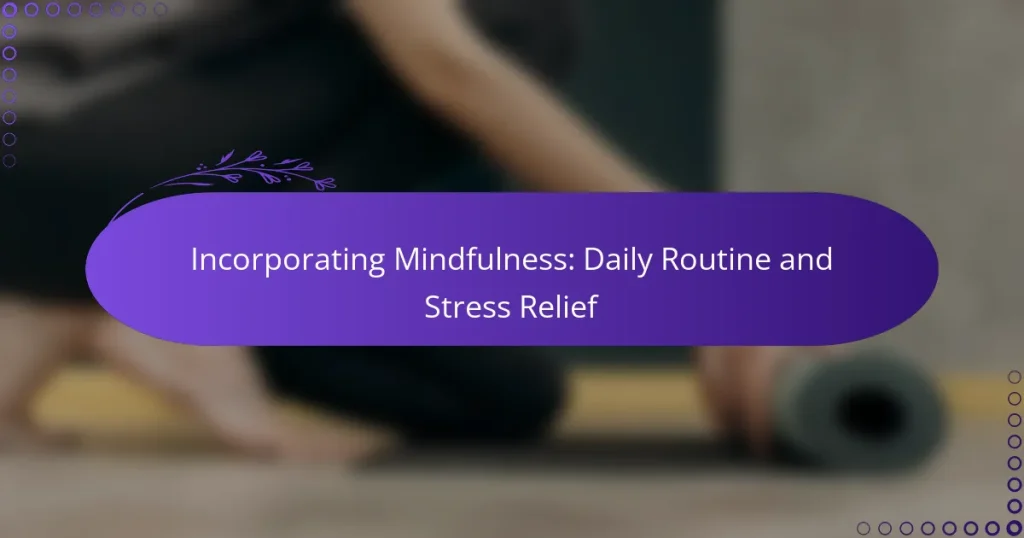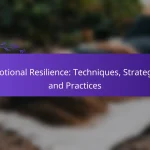Incorporating mindfulness into your daily routine can significantly enhance your well-being and reduce stress. By engaging in simple practices such as meditation, mindful eating, and reflection, you can cultivate awareness and presence throughout your day. These techniques not only help manage anxiety but also promote emotional resilience, allowing you to navigate life’s challenges with greater ease.
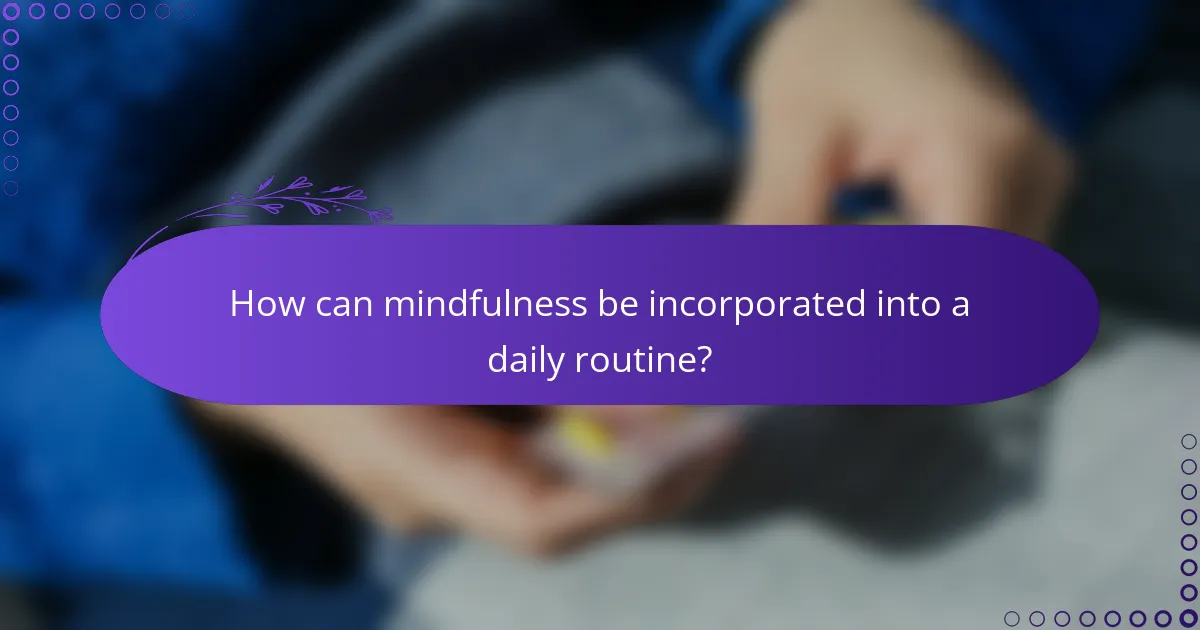
How can mindfulness be incorporated into a daily routine?
Mindfulness can be seamlessly integrated into your daily routine by incorporating simple practices that promote awareness and presence throughout the day. This can include structured activities like meditation, mindful eating, and reflection exercises that help reduce stress and enhance overall well-being.
Morning meditation practices
Starting your day with morning meditation can set a positive tone for the hours ahead. Aim for 5 to 15 minutes of focused breathing or guided meditation to cultivate a sense of calm and clarity. Consider using apps or online resources to find sessions that suit your preferences.
To enhance your practice, find a quiet space, sit comfortably, and focus on your breath or a specific mantra. This practice can help reduce anxiety and improve concentration throughout the day.
Mindful eating techniques
Mindful eating involves paying full attention to the experience of eating, which can improve digestion and satisfaction. Start by eliminating distractions during meals, such as phones or television, and focus on the flavors, textures, and aromas of your food.
Try to chew slowly and savor each bite, allowing yourself to recognize hunger and fullness cues. This practice can help prevent overeating and promote healthier food choices.
Evening reflection exercises
Evening reflection exercises can help you process the day and prepare for restful sleep. Spend a few minutes journaling about your experiences, focusing on what went well and what you are grateful for. This can foster a positive mindset and reduce stress.
Consider setting aside 10 minutes before bed for deep breathing or gentle stretching to unwind. These practices can help clear your mind and enhance your overall mindfulness before sleep.
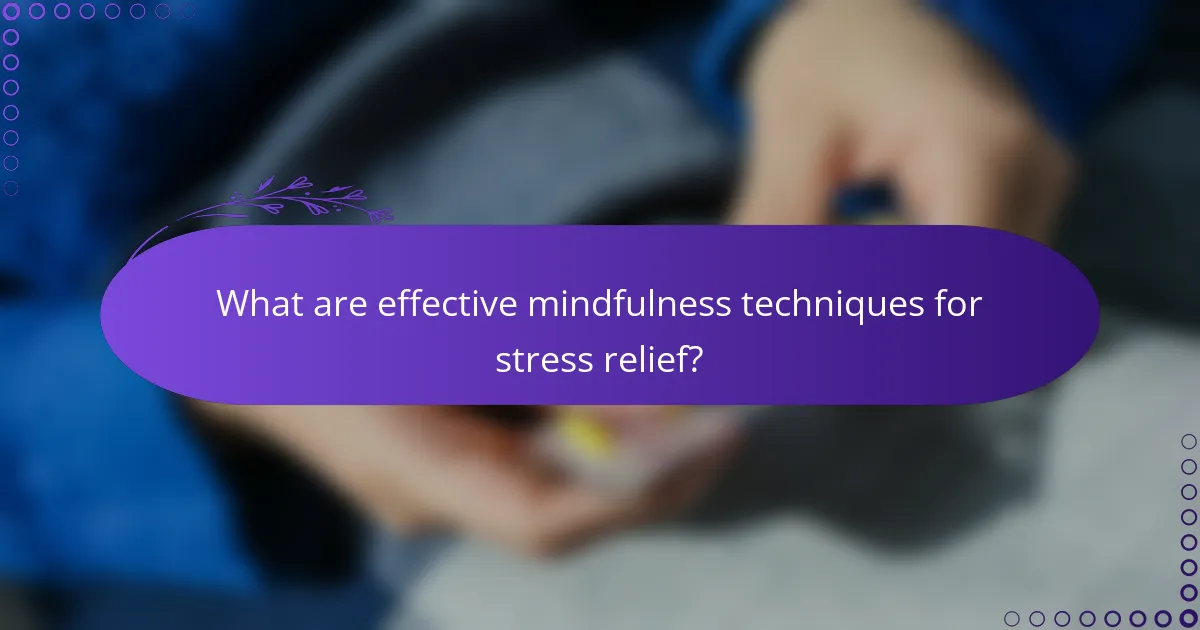
What are effective mindfulness techniques for stress relief?
Effective mindfulness techniques for stress relief include practices that enhance awareness and promote relaxation. These techniques help individuals manage anxiety and improve overall well-being through focused attention and intentional breathing.
Breathing exercises for anxiety
Breathing exercises are simple yet powerful tools for reducing anxiety and promoting calmness. Techniques such as deep belly breathing or the 4-7-8 method can help lower heart rate and induce relaxation.
To practice deep belly breathing, inhale slowly through your nose for a count of four, hold for a count of four, and exhale through your mouth for a count of six. Repeat this cycle for several minutes to experience its calming effects.
Body scan meditation
Body scan meditation involves mentally scanning your body for areas of tension and consciously relaxing them. This practice encourages awareness of physical sensations and helps release stress stored in the body.
To perform a body scan, lie down comfortably and focus on each part of your body, starting from your toes and moving up to your head. Spend a few moments on each area, noticing any tension and consciously relaxing it. Aim for a duration of 10-20 minutes for optimal benefits.
Guided imagery for relaxation
Guided imagery is a visualization technique that helps create a mental escape to a peaceful place, promoting relaxation and reducing stress. This technique can be particularly effective when combined with soothing music or nature sounds.
To practice guided imagery, find a quiet space, close your eyes, and imagine a serene environment, such as a beach or forest. Engage all your senses by visualizing the sights, sounds, and smells of this place. Spend 5-15 minutes in this visualization to enhance your sense of calm.

How does mindfulness impact mental health?
Mindfulness positively affects mental health by promoting awareness and acceptance of the present moment, which can lead to reduced stress and improved emotional well-being. Practicing mindfulness techniques can help individuals manage their thoughts and feelings more effectively, contributing to overall mental resilience.
Reduces symptoms of depression
Mindfulness has been shown to alleviate symptoms of depression by encouraging individuals to observe their thoughts without judgment. This practice can break the cycle of negative thinking that often accompanies depression, allowing for a more balanced perspective.
Engaging in mindfulness exercises, such as meditation or deep breathing, can lead to significant improvements in mood. Regular practice may help reduce depressive symptoms by fostering a sense of calm and increasing self-awareness.
Improves emotional regulation
Mindfulness enhances emotional regulation by helping individuals recognize and understand their emotions as they arise. This awareness allows for a more thoughtful response rather than a reactive one, which can lead to healthier interactions and decisions.
Techniques such as mindful breathing or body scans can be effective in managing emotional responses. By incorporating these practices into daily routines, individuals can develop greater control over their emotional states, reducing impulsivity and enhancing overall emotional stability.

What are the benefits of mindfulness in the workplace?
Mindfulness in the workplace offers numerous benefits, including improved focus, enhanced productivity, and reduced stress levels. By fostering a present-moment awareness, employees can better manage their tasks and emotional responses, leading to a healthier work environment.
Enhances focus and productivity
Practicing mindfulness can significantly enhance focus and productivity by training the mind to concentrate on the task at hand. Techniques such as mindful breathing or brief meditation breaks can help clear distractions, allowing employees to work more efficiently.
For example, dedicating just five minutes each hour to mindful breathing can help reset attention spans and improve overall work output. Employees who regularly engage in mindfulness practices often report feeling more engaged and less prone to procrastination.
Reduces workplace stress
Mindfulness is an effective tool for reducing workplace stress, as it encourages individuals to acknowledge and manage their stressors rather than react impulsively. By practicing mindfulness, employees can develop resilience against stress, leading to better emotional regulation.
Implementing simple practices, such as a short daily meditation or mindful walking during breaks, can create a more relaxed atmosphere. Organizations that promote mindfulness often see lower absenteeism and higher employee satisfaction, contributing to a more positive workplace culture.

What tools can assist with mindfulness practices?
Several tools can enhance mindfulness practices, making it easier to incorporate them into daily life. Apps like Headspace and Calm provide guided sessions that cater to various needs, such as meditation, relaxation, and sleep improvement.
Headspace app for guided meditation
The Headspace app offers a variety of guided meditation sessions designed to help users manage stress and improve focus. With options ranging from just a few minutes to longer sessions, it caters to both beginners and experienced practitioners.
Users can choose specific themes, such as anxiety relief or productivity enhancement, allowing for a tailored experience. The app also includes features like sleep sounds and mindful workouts, making it a comprehensive tool for mental well-being.
Calm app for sleep and relaxation
Calm is primarily focused on promoting better sleep and relaxation through soothing sounds and guided meditations. It features sleep stories narrated by well-known voices, which can help users unwind before bed.
In addition to sleep aids, Calm offers breathing exercises and mindfulness practices that can be integrated into daily routines. Users can track their progress and set reminders, making it easier to establish a consistent practice.

How can mindfulness be adapted for different lifestyles?
Mindfulness can be tailored to fit various lifestyles by integrating simple practices into daily routines. Whether you are a busy professional or a parent, there are effective ways to incorporate mindfulness that suit your unique circumstances.
Mindfulness for busy professionals
For busy professionals, mindfulness can be integrated into short breaks throughout the workday. Techniques such as deep breathing, brief meditation sessions, or mindful walking can be effective in reducing stress and enhancing focus.
Consider setting aside 5-10 minutes during lunch or between meetings to practice mindfulness. Use apps that guide you through quick sessions, helping you recharge without needing extensive time commitments.
Avoid multitasking during these moments; focus solely on your breathing or the sensations around you to maximize the benefits. This practice can lead to improved productivity and a clearer mind.
Mindfulness for parents
Parents can adapt mindfulness by incorporating it into family activities or personal moments. Simple practices like mindful eating during meals or taking a few minutes for deep breathing while the children play can create a peaceful atmosphere.
Engage children in mindfulness by introducing games that focus on awareness, such as nature walks where you discuss what you see and hear. This not only benefits parents but also teaches children valuable skills for managing stress.
Set realistic expectations; even a few minutes of mindfulness can be beneficial. Prioritize consistency over duration, aiming for daily practice that fits within your family’s routine.
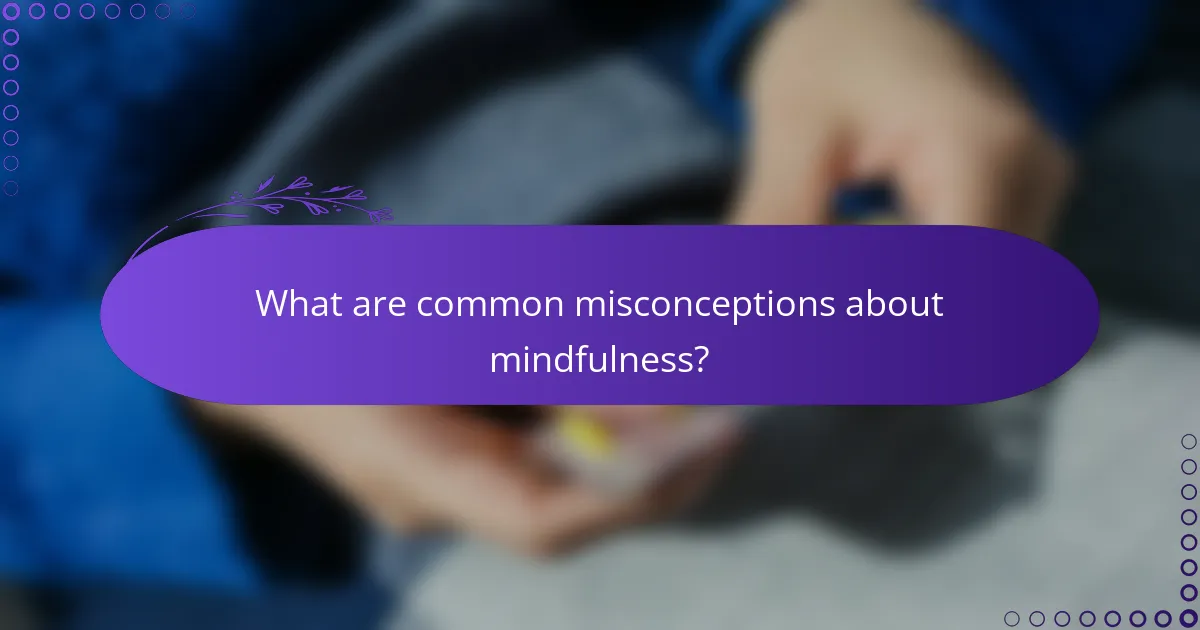
What are common misconceptions about mindfulness?
Many people believe that mindfulness is solely about meditation, which limits its broader applications in daily life. In reality, mindfulness can be integrated into various activities and routines, enhancing overall well-being and reducing stress.
Mindfulness is only for meditation
While meditation is a popular practice for cultivating mindfulness, it is not the only way to achieve a mindful state. Mindfulness can be practiced during everyday activities such as eating, walking, or even washing dishes. The key is to focus fully on the present moment and engage with your senses.
For example, when eating, you can take time to savor each bite, noticing the flavors and textures, rather than rushing through your meal. This approach can help reduce stress and increase your enjoyment of food, leading to healthier eating habits.
To incorporate mindfulness into your daily routine, try setting aside a few minutes each day to practice being present. This could be as simple as taking deep breaths while waiting for your coffee or paying attention to the sounds around you during a short walk. Remember, mindfulness is about awareness, not just meditation.
